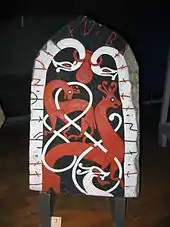Old Norse poetry
Old Norse poetry encompasses a range of verse forms written in Old Norse, during the period from the 8th century (see Eggjum stone) to as late as the far end of the 13th century. Most of the Old Norse poetry that survives was preserved in Iceland, but there are also 122 preserved poems in Swedish rune inscriptions, 54 in Norwegian and 12 in Danish.[1]
| Part of a series on |
| Old Norse |
|---|
 |
|
|
Poetry played an important role in the social and religious world of the Vikings. In Norse mythology, Skáldskaparmál (1) tells the story of how Odin brought poetry to Asgard, which is an indicator of the significance of poetry within the contemporary Scandinavian culture.
Old Norse poetry is characterised by alliteration, a poetic vocabulary expanded by heiti, and use of kennings. An important source of information about poetic forms in Old Norse is the Prose Edda of Snorri Sturluson.
Old Norse poetry is conventionally, and somewhat arbitrarily, split into two types—Eddaic poetry (also sometimes known as Eddic poetry) and skaldic poetry. Eddaic poetry includes the poems of the Codex Regius and a few other similar ones. Skaldic poetry is usually defined as everything else not already mentioned.
Metrical forms

Old Norse poetry has many metrical forms. They range from the relatively simple fornyrðislag to the deeply complex dróttkvætt, the "courtly metre".
In Eddic poetry, the metric structures are generally simple, and are almost invariably ljóðaháttr or fornyrðislag. Ljóðaháttr, (known also as the "metre of chants"), because of its structure, which comprises broken stanzas, lends itself to dialogue and discourse. Fornyrðislag, "the metre of ancient words", is the more commonly used of the two, and is generally used where the poem is largely narrative. It is composed with four or more syllables per line. Other metrical forms include
- Málaháttr is similar to fornyrðislag, but with a fixed metrical length of five syllables.
- Hrynhenda, a variant of dróttkvætt, which uses all the rules of dróttkvætt, with the exception that the line comprises four metrical feet rather than three.
- Kviðuháttr, another variant of fornyrðislag with alternating lines of 3 and 4 syllables
- Galdralag, the "magic spell metre", which contains a fourth line which echoes and varies the third line
Eddaic poetry
The Eddaic poems have the following characteristics.
- The author is always anonymous.
- The meter is simple, fornyrðislag, málaháttr or ljóðaháttr.
- The word order is usually relatively straightforward.
- Kennings are used sparingly and opaque ones are rare.
Skaldic poetry
The skaldic poems have the following characteristics.
- The author is usually known.
- The meter is ornate, usually dróttkvætt or a variation thereof.
- The syntax is ornate, with sentences commonly interwoven.
- Kennings are used frequently.
See also
References
- "skaldic poetry project". Skaldic.arts.usyd.edu.au. Archived from the original on 2016-03-11. Retrieved 2015-03-19.
- Den norsk-islandske skjaldedigtning ved Finnur Jónsson, 1912–1915
- Carmina Scaldica udvalg af norske og islandske skjaldekvad ved Finnur Jónsson, 1929